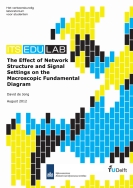Recently it has been proposed that the performance of a complete network can be represented graphically using only aggregated data for flow and density. The resulting graph is the macroscopic fundamental diagram (MFD), which relates the average flow and the average density (network density) of a network to each other. The resulting shape is often concave, meaning that the network output could be maximised if a fixed number of vehicles can be maintained in a network. In order to gain a deeper insight into what factors affect the shape of the MFD, how the MFD is related to the structure of a network and whether or not it is applicable for control strategies, this thesis aims to answer the following research questions:
1. Does a relationship exist between the shape of the macroscopic fundamental diagram and the structure of the underlying network and on which factors does this depend?
2. Is the macroscopic fundamental diagram of the subnetwork and its perimeter affected by different signals settings and does this affect its applicability for control strategies?
In order to investigate these effects in different networks, a model has been developed, which fully automates the creation of different networks (including controlled intersection with full signal schemes) for a microscopic simulation model. With this model 7 networks, measuring 3×3 km have been created and simulated, in order to obtain multiple MFDs to answer how the network structure affects the shape of the MFD. In each of these networks one or more subnetworks (neighbourhoods) were created, by adding additional arterials in the network. In order to assess the effect of different signal settings on the MFD of the subnetwork and its perimeter, the traffic flow is restricted by changing the timing of the traffic signals in both the perimeter and the subnetwork.
Regarding the relation between the shape of the MFD and the network structure, it is concluded that the structure of a network in itself does not have a strong influence on the shape of the MFD. Differences between MFDs are not to be caused by topological differences, but by the different characteristics of the links (length, speed, capacity) and the intersections in the underlying network. Substantial and consistent differences are found for controlled and uncontrolled parts of the network, as signalised parts of the networks often have a maximum performance and optimal accumulation twice that of non-signalised parts.
Regarding the effect of signal settings on the shape of the MFD of a subnetwork and its perimeter and its applicability for control strategies, it is concluded that a strong relation between the MFD of the subnetwork and its perimeter does exist, in which both react in the same way to changes in traffic demand. Changes in the signal settings can have a strong impact on the shape of the MFD of both the subnetwork and its perimeter. The ratio between the performance of the subnetwork and perimeter is highly consistent and not directly affected by changes in the signal settings. As a result of optimising the signal timings, more traffic can be processed in the network and the performance will eventually increase as well. The optimal accumulation of the perimeter is found to be highly sensitive to changes in the signal settings. As a consequence it is concluded that the MFD is difficult to use for control strategies aiming to adapt signal timings, in order to maintain the optimal accumulation in a part of the network, because these changed signal timings result in a different optimal accumulation.
The shape of the MFD is far from consistent and can be changed by a lot of different factors. How each factor exactly influences the shape is still not fully understood. As such, it is recommended one should be careful in using the MFD for evaluation studies, as input for control strategies, or as a basis for policy-making decisions.
